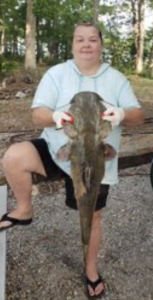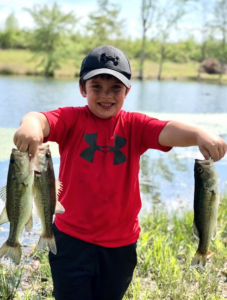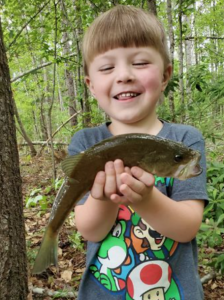
HOW TO SET UP A HEALTHY POND
To create a pond that you will find rewarding OR to take control of a pond that is not working for you, ask yourself what your goals are for your pond…
- Is it to set up a fantastic Bass Pond, or a great family and friends fishing pond? Is it to have a no maintenance pond at a vacation property?
- Is it to gain control of a pond that is not stocked well, or a pond that is over-run with weeds or algae?
- Is it to have a nice selection of fish species to fish for, or a pond stocked to steadily provide food for the table?
On our ARTICLES page you will find the different types of ponds listed with specific fish and quantities per acre. Be sure to visit that page, and call the Office if you have questions or need assistance figuring your pond stocking out.
If you need counsel on creating your new pond, here is a link to a Video Series on that subject. The entire Video Series has links posted on our ARTICLES page: http://research.dcnr.alabama.gov/pond-management/section2/index.html
It’s useful to think of a pond like an underwater garden. Gardens exist in various stages of development from seedling all the way to fully developed garden, to a garden in decline or needing to be re-planted.
You will want to set your pond up with the right fish species to meet your goals for the best outcome. We can help you sort out what you want, and what order of stocking to develop your pond or lake in the best way. Developing and maintaining a pond or lake is an ongoing process, and if needed, we provide counsel on an ongoing basis season by season or year by year. We do not come out and evaluate ponds, but we assist you with things to look for, which will tell us a lot about your pond. Then we can give counsel based on what you tell us.
POND SIZE: First off, we recommend that you calculate the size of your pond. You need to know the size of your pond or number of surface acres in your pond (if you don’t know the number) so that you know how many fingerlings your pond can hold. Here is the link from our Articles page on how to calculate pond acres:
https://www.alabamafishandpond.com/how-to-calculate-your-ponds-surface-acres-2/
POND TYPE: You also need to decide what type of pond you want (Bass, Catfish or mixed) and how much effort you want to put into the pond to maintain it. Then you can then sort out your stocking plan and finally how much you want to spend and where that limits your stocking if you have a set amount you want to spend.
Ponds and lakes will have a maximum amount of fish that can be supported based on the water depth, water clarity or quality, food supply and supplemental feeding, the fish and fingerlings you stock and if your pond needs fertilizing or not.
POND WATER COLOR: For example if you have water than runs toward clear then the newly spawned Fry will have a hard time finding enough to eat. You may lose 30-40% of the Fry each Season. In that case you need to plan to restock at some level, instead of counting on reproduction.
In a clear water pond you may be able to harvest up to 40 lbs of adult Bluegill (about 120 of them) and about 10 lbs of Bass (8-10 Bass per acre) per year in a fully stocked pond.
In a more fertile pond with water toward green you can harvest up to 160 lbs of Bluegill and 35-40 lbs of Bass per acre each year (in a fully stocked pond). Here is a good article on the subject, and we cover more below:
https://www.dgif.virginia.gov/fishing/private-pond-management/managing-fish-populations/
What color your pond/lake is can be a tricky subject. Here is a great Article on the subject: https://blog.pondking.com/could-my-pond-be-too-clear
FEEDING: We recommend regular pellet feeding for Bluegill and Catfish if you want maximum growth. If you are busy and have the funds, we suggest that you set up an automatic Fish Feeder for the healthiest fish and pond. You can feed in the morning and evening, providing enough feed for your fish to clean up in 10 to 15 minutes. You should offer Fingerling sized high protein floating food (1/8″ sized high-protein pellets (41% protein) through the Summer months. As your fish grow it will take more food to feed them for 10 to 15 minutes, and that is how you determine how much to throw by hand or spray from the Feeder. You should feed at the same place and around the same time each day. Do not feed off of a Dam or over deep water. Smaller fish will not want to skyline themselves over predators. All creatures benefit from being fed twice a day.
If you are feeding by hand we recommend that you broadcast 1-2 gallons of BB sized or 1/8″ sized high protein pellets per acre each evening about dusk. You are looking to see the amount of pellets that the fish will clean up within 30 minutes.
IMPACT OF FEEDING: Most people want Catfish in a Bass pond. This is an issue because once Catfish get above 2 lbs they start competeing with Bass for small fish and can start them starving and stunting. Because of the rapid growth rate of Catfish, feeding the pellets each day takes the strain of finding enough food off of them, and causes them to leave more of the small Bluegill to the Bass. Catfish become fat and lazy pets with regular pellet feeding. With daily pellet feeding you will end up with more big Bass, Bluegill and other species for your frying pan.
If you are going to start a feeding program you need to be consistent. Evening, around dusk is the best time to feed each night. After about a week of consistent feeding you will see fish coming to you to feed. The fish will be poorly impacted if you feed an inferior or low protein feed, and you will not get the same results as with high protein feed in the 1/8″ size. Adult fish can eat baby sized feed, but babies can’t eat the adult pellets until it deteriorates/softens. We recommend that you do not use large pellet sizes. Anything over 1/8″ (or BB size) will prevent the Bluegill from feeding.
If fishing for Bluegill is a goal, feed fish meal in shallow areas to support Bluegill fry. Another important thing to know if you want to grow large Bluegill is to keep feeding pelleted feed into the winter months, until the water temperature drops to 40 degrees. Bluegill will continue to feed until then.
You should note that Bass, Shellcracker and Crappie/Hybrid Crappie do not train to feed. They need established or stocked ponds with live feed. Bluegill (Bream) and Catfish do train to feed.
Another thing to note is that pond size doesn’t determine the size of your fish, feeding does. The difference in smaller and larger ponds is that larger ponds can create more food for fish naturally. If you feed 1/8″ high protein pellets throughout the Summer and restock Minnows each year, you can have large fish in a smaller pond.
FERTILIZING and LIMING: If you have the funds, plan to fertilize your pond each year AND plan to treat your pond with Lime every 2 to 3 years. Doing this will increase the natural food supply in your pond or lake (algae, zooplankton and aquatic insects) thereby increasing pond health and fish size. This will cause those spawned Fry to thrive and reach adulthood.
Ponds without fertilization will usually only support 100 to 150 lbs of living fish per acre in your pond. This includes ALL the types of fish in the pond. Ponds that are properly fertilized and limed can support an average 300 lbs of fish PER ACRE. This is why fertilizing and liming is so useful and important. Here is a good article on the subject:
http://www.mdwfp.com/fishing-boating/pond-assistance/liming-fertilization
Adding Lime will increase the ph of your pond and will help prevent ph fluctuation. 1 to 2 tons of Lime per surface acre will raise the pond ph by 1 to 2 units. Lime can also be used to sterilize ponds prior to stocking. Here is a good article on Lime:
http://edis.ifas.ufl.edu/fa028.
This is a quote from the linked article: “Identifying liming needs can be accomplished by taking either a water or soil sample from the pond. Measuring the total alkalinity, total hardness, and pH of water in the pond is the most effective and easiest way to determine if liming is necessary. Local county extension offices are often equipped with simple test kits to measure the chemistry of a water sample or can assist you with purchasing a test kit of your own, or in sending a water sample to a lab for analysis. Liming is recommended for ponds with a total alkalinity of less than 20 ppm. Application of 4.5 pounds of lime per acre-foot of water (one acre of water that is one foot deep) will increase the total alkalinity approximately 1 ppm.
Certain fish species require total hardness levels above 50 ppm for good health. For example, hybrid striped bass require total hardness levels above 100 ppm, and a minimum total hardness of 200 ppm is required for production of redfish. Liming increases the total hardness of water by the addition of calcium and magnesium ions. Application of 7 pounds of lime per acre-foot of water will increase the total alkalinity approximately 1 ppm.”
Before you launch in on a fertilizing and liming effort, ask yourself if you will stick with it over the years. If you increase the fertility of your pond and cause the Fry to do well and then abruptly stop you may throw your pond/fish into distress and drop your survival rate percentages. It may be better to not start, then to start and stop. If you want low maintenance or a low cost pond, you can plan to re-stock fingerlings instead of having to fertilize and lime each year.
In summary, stocking your pond with the right numbers and species of fish fingerlings, controlling aquatic weeds, providing regular feeding, deciding if you will maintain a fertilizing and liming program at the right times, and fishing to harvest for population control will give you a pond to enjoy for years to come.



